
Create your own journey; Experience the best of Northern Spain at your own pace
This website uses its own and third-party cookies, for the proper functioning of the site and to generate usage statistics.
By continuing to browse we understand that you consent to our �ookie policy
Embark on an enthralling pilgrimage from Avilés to Santiago, traversing around 340 kilometers on the Camino del Norte.
The initial stages of this route take you along the coast, where you'll face some challenges, including ascents and descents, some stretching 2-3km. Overcoming these stages, you'll encounter the peaceful valleys adorned with rivers and lakes, creating a serene and tranquil setting. In Ribadeo, you'll leave behind the sea views and immerse yourself in the beauty of the Galician countryside.
Throughout the journey, marvel at the region's rich culture and historic architecture. Discover the cobblestoned streets of coastal towns, ancient monasteries, and cathedrals, each telling centuries-old stories of tradition and spirituality.Click on Request a quote (on the right column) and receive a personalized offer for your trip with no binding commitment.
✔ Daily Departures from March to October.
✔Carefully selected hotels, always with a private bathroom.
✔ A personalized digital guide from Spain is More with practical information about the route and recommendations.
✔ Dividing stages: Yes, sometimes.
✔ If you feel like extending your stay in one of the holiday coastal towns before or after your pilgrimage, ask us. We know the best places and would be delighted to make a reservation for you.
Click here to explore the Camino del Norte
Find key insights on distances, terrain, climate, and vital tips.
Camino De Santiago: Northern Way
(Avilés-Santiago)

Arrival to Avilés, normally by train from Madrid, however, we can always tailor the local tranpsort depending on your arrivalpoint in Spain. Avilés is primarily known for its cultural center, which was designed by the famous Brazilian architect Oscar Niemeyer. The city also has a nice old town. A pleasent city to spend the first night to enjoy the old quarler.

During this stage and the many days following, you will nearly always be able to enjoy the sea on your right. The rocky coastline is sometimes hard to reach, but wide, long white sandy beaches often open up.
Today, the stage ends in one of the most charming fishing villages on the Spanish Northern Coast.

A mixed stage, as you follow a bit of the Camino and later some miles along the road. Nevertheless, a stage through forests and often with a beautiful view of the sea.
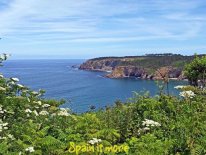
Over 50 meter vertical rock walls separate you and the sea on this stage, often with small, almost pristine beaches in between.
Distance: 20 Km
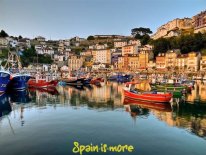
The stage is relatively flat and quite easy (if it is not windy) and ends in one of the northern coast’s most-beloved villages, Luarca, which is often among the villages highlighted when magazines and newspapers vote on "Spain's most beautiful village".
Distance: 16 Km
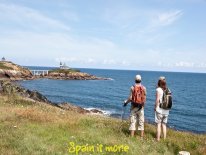
In many ways similar to yesterday's stage. It is relatively flat with beautiful views, beaches, pine forests and open countryside.
Distance: 26 Km
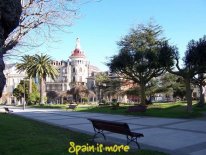
You will be leaving Asturias and saying hello to Galicia.
Here, you are very close to one of the world's most beautiful beaches, Playa de las Catedrales, and the afternoon will include a visit to the beach.
The tour includes transportation to and from the beach from the hotel in Ribadeo and some time to see the beach. Playa de las Catedrales is approximately 10 kilometers from Ribadeo.
Perhaps you can consider a rest day in Ribadeo and have time to enjoy this cozy town and possibly the nearby beaches before the trip goes inland.
Distance: 26 Km
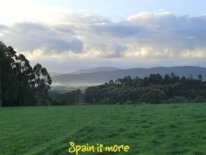
You move away from the many small villages along the coast and into the highlands. The terrain thus becomes hillier and the contour line increases to about 300 meters (1,000 feet). Setting out, you get a last glimpse of the coast before finally saying goodbye to the sea.
At the same time, you are moving into a very unknown and rural Spain, where you will see old farming methods and small towns where you would be the only tourist were it not for the Camino.
It's an interesting and different part of the Camino starting with this stage.
Distance: 26 Km
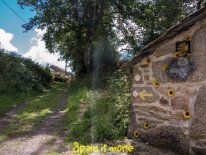
This stage goes through the city of Mondoñedo, which houses one of the northern route's most beautiful cathedrals and thus one of the main monuments along this route. The city and the area are also home to a few interesting monasteries.
Galicia is in many ways very different from Asturias, but one of the most visual differences is the many "horreos" that you can find anywhere. These ancient "refrigerators" will constantly remind you that you are in Galicia.
Distance: 25 Km
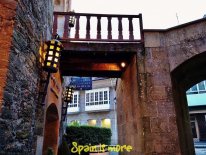
An easy stage without significant obstacles, a day for enjoyment and mental relaxation. You will probably stay the night in Vilalba’s beautiful parador hotel.
Vilalba is a large town with several good restaurants and is the last larger town before you move into a relatively deserted area.
Distance: 21 Km
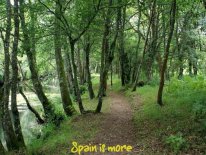
After about 10 kilometers, you will leave the highway that you have been crossing many times over the last couple of days. You will walk into a very rural area with lots of open fields, forests, etc.
Distance: 26 Km
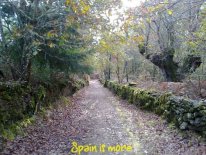
A stage which in many ways is similar to yesterday's stage, where forests, ponds and fields surround you.
The cultural highlight of the day is the monastery in Sobrado.
Distance: 24 Km
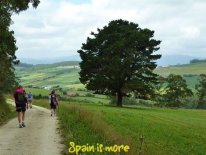
This is the last stage before the northern route integrates with the French route in Arzúa.
From here, you are only two stages from your goal in Santiago, and you will meet many pilgrims who want to learn more about Camino del Norte.
Distance: 21 Km
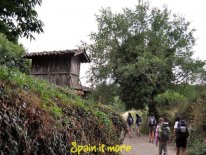
An exhilarating atmosphere unfolds as your journey's end draws closer.
Pilgrims now see and feel their goal, and begin to revel in happiness and relief with the many companions they met along the way.
Distance: 20 Km
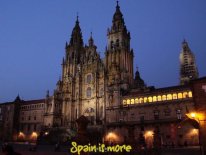
Congratulations, you achieved an admirable goal, so it's time for a number of traditional pilgrimage rituals. First, be sure to get proof of this feat: the last stamp in your pilgrim passport.
Along with the rituals, enjoy the End Station of the Pilgrim route, Santiago de Compostela, which offers a veritable cornucopia of attractions and one of the world’s most important cultural centers.
This university town exudes charm and has a myriad of cozy streets offering ample opportunity to sample the many local delicacies. The cathedral is surrounded by a historic center which is on UNESCO’s World Heritage Site list, and old town is incomparable. Its monuments stand as true works of art in different architectural styles.
Distance: 19 Km

True pilgrims continues further and finish their journeys in Finisterre. The tour goes by bus with an English-speaking guide from Santiago to Finisterre in the morning and returns mid-efternoon to Santiago. Just off the stunning, rugged coastline and the fabled “Costa de la Muerte” (Death Coast), a reef filled with shipwrecks and tales of legends captures a raw, natural beauty. On the coast’s westernmost point is Finisterre – meaning the world’s end. Romans named this coast because it was literally the end of the known world. For many pilgrims this is the symbolic endpoint of the pilgrimage.
The evening is spent in Santiago de Compostela.

Departure from Santiago.
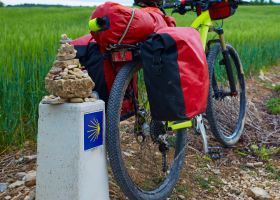
Pilgrimage by bike through incredible landscapes
9 days / 8 nights
From 850 EUR/pers.
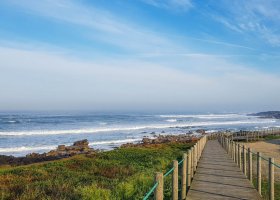
Pilgrimage along the St. James Way from Porto to Santiago along the coast.
16 days / 15 nights
From 1250 Euro/pers.
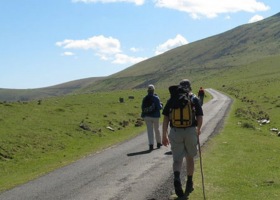
Pilgrimage from France to the vineyards of La Rioja crossing the Pyrenees
9 days / 8 nights
From 650 Euro/pers.
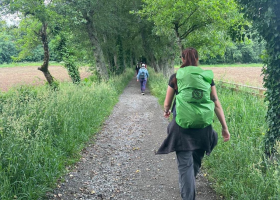
Pilgrimage along the last 116 km from Sarria to Santiago.
8 days / 7 nights
From 630 EUR/pers.

Results of research into the psychological benefits of a camino announced

njoy the Camino with the best planning